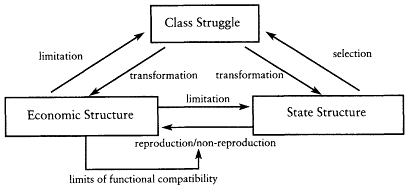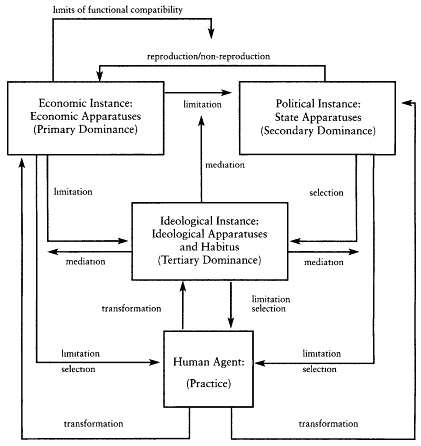Wright: Modes of Determination Within Structural Causality
I begin by defining with greater precision the concept of structural causality, in particular, by specifying qualitative differences in the relations of determination that may exist among the different instances articulated as the complex whole of a social formation. In Class, Crisis, and the State , American sociologist Erik Olin Wright has suggested that structural causality is a global concept that may be broken down into six distinct forms of causality or modes of determination (Wright 1978, 15-25):
1. Structural limitation is a pattern of determination in which some social structure establishes limits within which some other structure or process can
vary and which establishes probabilities for the specific structures or processes that are possible within those limits.
2. Selection constitutes those social mechanisms that concretely determine ranges of outcomes or, in the extreme case, specific outcomes, within a structurally limited range of possibilities. In a sense, selection is a second-order form of limitation: the setting of limits within limits. Wright specifies two complementary forms of selection, positive (mechanisms that determine specific outcomes among those that are possible) and negative (mechanisms that exclude certain possibilities).
3. Reproduction/non-reproduction refers to the facilitation/inhibition of change within one structure by a second. To say that one structure functions to reproduce another implies that the reproducing structure prevents the reproduced structure from changing in certain fundamental ways. This process differs from limitation, Wright maintains, since in the case of limitation, there is no presumption that the determined structure would necessarily change, whereas in the case of reproduction such changes would normally occur. In addition, reproduction/non-reproduction is a variable relation of determination since it implies that the determining structure may become non-reproductive vis-à-vis the determined structure.
4. Limits of functional compatibility specify the mechanisms by which structural forms will be functional with respect to other structural forms and in what ways—in other words, which forms will be reproductive and which non-reproductive.
5. Transformation refers to a mode of determination by which class struggle (practice) directly affects the processes of structural limitation, selection, and reproduction/non-reproduction.
6. Mediation defines a mode of determination in which a given social process shapes the consequences of other social processes. In other words, it is a "contextualizing variable" that shapes the very nature of the relationship between two other variables.
Wright's modes of determination lend greater precision to general concepts such as overdetermination, structural causality, relative autonomy, determination in the last instance, and structure in dominance. Because his terms are capable of greater specification, Wright believes that they are more open to empirical verification as hypotheses and considerably enrich our ability to grasp theoretically a wide variety of concrete social formations. As we have repeatedly insisted, the method of Structural Marxism is not rationalist or idealist; concrete social relations cannot be deduced or read off from abstract concepts. Structural Marxism is neither reductive nor essentialist. It does not dogmatically eliminate the particular by means of the general; rather, it grasps the particular through the general and revises the general in light of the

Figure 1.
The relationship between the economy and the state (Wright 1978, 20).
particular. It is realist and materialist in the sense that structural relationships are held to have an objective, real existence and that we can obtain objective knowledge of them.
Structural relationships have material effectivities that are not only qualitatively distinct but also quantitatively unequal, stratified by their relative determinative significance or dominance. Unfortunately, as Wright explains them, the various modes of determination lack any hierarchical relationship to each other. Because they lack determinative weights themselves, or more accurately because the economic, political, and ideological instances whose articulation they define are devoid of relations of dominance, the modes of determination described by Wright exist in a circular or feedback relationship whereby everything somehow causes everything else. For example, Wright posits the reciprocal relationship between the economy and the state as shown in figure 1.
While one may agree with Wright's description of the relationship between the economy and the state as reciprocal—the economy determining the state by a relation of limitation; the state determining the economy by a relation of reproduction/non-reproduction—it remains unclear which structure, and therefore which relation, is dominant. The problem is compounded as Wright proceeds to add "class struggle" to his model, as shown in figure 2. Now we are faced with the question of the causal priority between relations of transformation and limitation that obtain among "class struggle," the economy, and the state.
Wright attempts to escape the problem by recourse to the "dialectical character of patterns of determination," but this is less an explanation than an admission of confusion: "class struggle, which is itself structurally limited and selected by various social structures, simultaneously

Figure 2.
The relationships among the economy, the state, and class struggle (Wright 1978, 22).
reshapes those structures. The word 'simultaneously' is important in this formulation: social structures do not first structurally limit and select class struggle, after which class struggle transforms those structures. Class struggle is intrinsically a process of transformation of structures, and thus the very process which sets limits on class struggle is at the same time transformed by the struggles so limited" (Wright 1978, 21). The use of "simultaneously" in this passage is obfuscatory and begs the question of structural dominance. The fact that different modes of determination are simultaneously at work is no argument for their equality. Wright also slips from structural to transitive causality and ends up focusing on an endless chain of cause and effect, unable to advance beyond a superficial description of patterns of events. Such a transitive "dialectic" is incapable of discerning the existence of generative structural mechanisms beneath patterns of events, mechanisms whose unequal effectivities determine precisely why certain patterns occur and not others. Finally, Wright's description of class struggle as a process that sets limits "at the same time [that it is] transformed by the struggles so limited" blurs the significant distinction between the irreversible, or intransitive, articulation of structural forces constituting social subjects (and every possible practice) with the interactive, open-ended, or transitive, practices of individuals (invested with and constrained by social powers).
To eliminate the circular, transitive causality implied by Wright's model and transcend the classic hermeneutic fallacy of theoretical hu-
manism (and political voluntarism) that underlies his conception of "class struggle," it is necessary to insist on the hierarchical stratification, in descending order, of the economic, political, and ideological instances. I will not repeat arguments already made regarding the primacy of the economic instance and the tertiary effectivity of the ideological field of institutional apparatuses, social subjects, and the habitus, nor will I anticipate the discussion of the intermediate effectivity of the political instance that is the subject of the present chapter. Here I wish only to clarify the term class struggle , which in its present form obscures rather than illuminates the relationship between structural determinations and the practice of social subjects. In Wright's usage the concept of class struggle is an empty generalization because he excludes the ideological instance and thus the very processes by which social subjects are constituted as class subjects. Wright evades, in effect, the central question of what class struggle actually is in order to assert not only its existence but also its primacy, that is, its transformative effect on political and economic structures.
In posing the question of class struggle, it is necessary to represent the field of practice not, as Wright does, as self-evidently inscribed with economic determinations and political values yet at the same time independent and coequal with respect to political and economic structures, but rather, following Althusser and Poulantzas, as the "matrix effect" of the articulation of economic, political, and ideological structures on the capacity of social subjects to act. That the field of practice is, in the last instance, a field of class practices and class struggle follows from the primacy of economic relations within the articulation of the instances whose matrix effect the field of practice is. In other words, practices are class practices insofar as they are activities of social subjects interpellated by the hierarchical articulation of the economic, political, and ideological instances, as members of what Poulantzas defines as social (as opposed to simply economic) classes. Similarly, the field of practice, what Pierre Bourdieu calls the "social space," is a class field insofar as the structure of positions and powers that constitutes it is the matrix effect of this same articulation. The concept of social class will be discussed at greater length in a moment. I introduce it now to explain why, in figure 3, the concept of the ideological instance, composed of ideological apparatuses and the habitus, is used in place of the term class struggle employed by Wright. This change requires yet another since it is now necessary to add the human agent to the model in

Figure 3.
Modes of determination in contemporary capitalism.
order to distinguish the ideological instance from individual human beings interpellated as social class subjects.